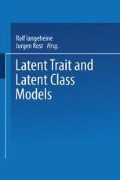Abstract
Data collected by social and behavioral scientists very often consist of large multidimensional tables of subjects cross-classified according to the values or states of several categorical variables. For example, Table 1 shows a set of data on suicide victims in which the method of committing suicide is cross-classified by sex and age group (Van der Heijden & de Leeuw, 1985) and Table 2 shows counts of subjects resulting from a survey of the political attitudes of a sample from the British electorate (Butler & Stokes, 1974). The analysis of such data should clearly depend on the substantive questions posed by the researcher involved, although in many cases these questions will be rather vague. The research worker may be interested in such notions as “pattern” and “structure” but it will often be left to the statistician to clarify what is meant by such concepts and whether they are present in the investigator’s data. Finally, the statistician has the often difficult task of explaining the results.
Access this chapter
Tax calculation will be finalised at checkout
Purchases are for personal use only
Preview
Unable to display preview. Download preview PDF.
References
Aitkin, M. (1985). Paper presented at Workshop on Comparison of Correspondence Analysis and Statistical Modeling. University of Lancaster.
Benzécri, J. P. (1969). Statistical analysis as a tool to make patterns emerge from data. In S. Watanabe (Ed.) Methodologies of pattern recognition pp. 35–74. New York: Academic Press.
Birch, M. W. (1963). Maximum likelihood in three-way contingency tables. Journal of the Royal Statistical Society, Series B, 25, 220–233.
Bishop, Y. M. M., Fienberg, S. E., and Holland, P. W. (1975). Discrete multivariate analysis: Theory and practice. Cambridge, Massachusetts: MIT Press.
Butler, D., and Stokes, D. (1974). Political change in Britain ( 2nd ed. ), London: Macmillan.
Dempster, A. P., Laird, N. M., and Rubin, D. B. (1977). Maximum likelihood from incomplete data via the EM algorithm. Journal of the Royal Statistical Society, Series B, 39, 1–38.
Everitt, B. S. (1977). The analysis of contingency tables. London: Chapman and Hall.
Everitt, B. S. (1984). An introduction to latent variable models. London: Chapman and Hall.
Everitt, B. S., and Hand, D. J. (1981). Finite mixture distribution. London: Chapman and Hall.
Fisher, R. A. (1940). The precision of discriminant functions. Annals of Eugenics, 10, 422–429.
Goodman, L. A. (1974). Exploratory latent structure analysis using both identifiable and unidentifiable models. Biometrika, 61, 215–231.
Green, B. F. (1951). A general solution of the latent class model of latent structure analysis and latent profile analysis. Psychometrika, 16, 151–166.
Greenacre, M. J. (1984). Theory and applications of correspondence analysis. London: Academic Press.
Haberman, S. J. (1979). Analysis of qualitative data: Vol. 2. New developments. New York: Academic Press.
Hill, M. O. (1974). Correspondence analysis: A neglected multivariate method. Applied Statistics, 23, 340–354.
Lazarsfeld, P. L., and Henry, N. W. (1968). Latent structure analysis. Boston, Massachusetts: Houghton Mifflin.
Lebart, L., Morineau, A., and Warwick, K. M. (1984). Multivariate descriptive statistical analysis, correspondence analysis and related techniques for large matrices. New York: Wiley.
Payne, C. (1977). The log-linear model for contingency tables. In C. A. O’Muircheartaigh and C. Payne (Eds.) The analysis of survey data (Vol. 2). London: Wiley.
Tukey, J. W. (1977). Exploratory data analysis. Reading, Massachusetts: Addison-Wesley.
Van der Heijden, P. G. M., and de Leeuw, J. (1985). Correspondence analysis and Complementary to Loglinear Analysis, Psychometrika, 50, 429–447.
Williams, E. J. (1952). Use of scores for the analysis of association in contingency tables. Biometrika, 39, 274–298.
Author information
Authors and Affiliations
Editor information
Editors and Affiliations
Rights and permissions
Copyright information
© 1988 Springer Science+Business Media New York
About this chapter
Cite this chapter
Everitt, B.S., Dunn, G. (1988). Log-linear Modeling, Latent Class Analysis, or Correspondence Analysis. In: Langeheine, R., Rost, J. (eds) Latent Trait and Latent Class Models. Springer, Boston, MA. https://doi.org/10.1007/978-1-4757-5644-9_6
Download citation
DOI: https://doi.org/10.1007/978-1-4757-5644-9_6
Publisher Name: Springer, Boston, MA
Print ISBN: 978-1-4757-5646-3
Online ISBN: 978-1-4757-5644-9
eBook Packages: Springer Book Archive

